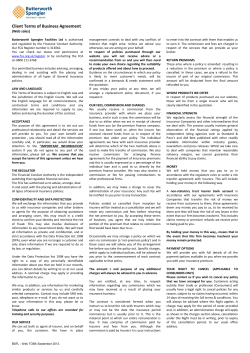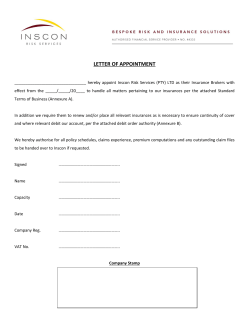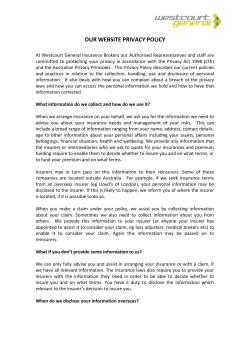
Chapter 5 Types of Insurers and Marketing Systems
Chapter 5 Types of Insurers and Marketing Systems Copyright © 2008 Pearson Addison-Wesley. All rights reserved. Agenda • Overview of Private Insurance in the Financial Services Industry • Types of Private Insurers • Agents and Brokers • Types of Marketing Systems • Group Insurance Marketing Copyright © 2008 Pearson Addison-Wesley. All rights reserved. 5-2 Overview of Private Insurance in the Financial Services Industry • The financial services industry consists of: – Commercial banks – Savings and loan institutions – Credit unions – Life and health insurers – Property and casualty insurers – Mutual Funds – Securities brokers and dealers – Private and state pension funds – Government-related financial institions Copyright © 2008 Pearson Addison-Wesley. All rights reserved. 5-3 Exhibit 5.1 Assets of Financial Services Sectors by Industry, 2005 ($billions, end of year) Copyright © 2008 Pearson Addison-Wesley. All rights reserved. 5-4 Overview of Private Insurance in the Financial Services Industry • Changes in the financial services industry include: – Consolidations • The number of firms has declined due to mergers and acquisitions – Convergence • Existing financial institutions now sell a wide variety of financial products that earlier were outside their core business area Copyright © 2008 Pearson Addison-Wesley. All rights reserved. 5-5 Exhibit 5.2 Insurance Companies That Own OTS-Regulated Thrifts, by Assets, 2005a $000) Copyright © 2008 Pearson Addison-Wesley. All rights reserved. 5-6 Types of Private Insurers • Size of the insurance market, 2004 – Life and health insurers: 1179 • These insurers sell life and health insurance products, annuities, mutual funds, pension plans, and related financial products – Property and casualty insurers: 3300+ • These insurers sell property and casualty insurance and related lines, including marine coverages and surety and fidelity bonds Copyright © 2008 Pearson Addison-Wesley. All rights reserved. 5-7 Exhibit 5.3 Top Twenty U.S. Life/Health Insurance Groups and Companies by Revenues, 2005 ($ millions) Copyright © 2008 Pearson Addison-Wesley. All rights reserved. 5-8 Exhibit 5.4 Top 20 U.S. Property/Casualty Companies by Revenues, 2005 ($millions) Copyright © 2008 Pearson Addison-Wesley. All rights reserved. 5-9 Types of Private Insurers • Insurers can be classified by their organizational form: – – – – – – – Stock insurers Mutual insurers Reciprocal exchanges Lloyd’s of London Blue Cross and Blue Shield Plans Health maintenance organizations (HMOs) Other types of private insurers Copyright © 2008 Pearson Addison-Wesley. All rights reserved. 5-10 Types of Private Insurers • A stock insurer is a corporation owned by stockholders – Objective: earn profit for stockholders • Increase value of stock • Pay dividends – Stockholders elect board of directors – Stockholders bear all losses – Insurer cannot issue an assessable policy Copyright © 2008 Pearson Addison-Wesley. All rights reserved. 5-11 Types of Private Insurers • A mutual insurer is a corporation owned by the policyowners – Policyowners elect board of directors, who have effective management control – May pay dividends to policyowners, or give a rate reduction in advance – There are three main types of mutual insurers: • An advance premium mutual is owned by the policyowners; there are no stockholders, and the insurer does not issue assessable policies • An assessment mutual has the right to assess policyowners an additional amount if the insurer’s financial operations are unfavorable • A fraternal insurer is a mutual insurer that provides life and health insurance to members of a social or religious organization Copyright © 2008 Pearson Addison-Wesley. All rights reserved. 5-12 Types of Private Insurers • The corporate structure of mutual insurers is changing due to: – An increase in company mergers – Demutualization, in which a mutual company is converted into a stock insurer by: • Pure conversion • Merger • Bulk reinsurance – The creation of mutual holding companies • A holding company is a company that directly or indirectly controls an authorized insurer Copyright © 2008 Pearson Addison-Wesley. All rights reserved. 5-13 Exhibit 5.5 Alternative Modes of Demutualization Copyright © 2008 Pearson Addison-Wesley. All rights reserved. 5-14 Exhibit 5.6 Mutual Holding Company Illustration Copyright © 2008 Pearson Addison-Wesley. All rights reserved. 5-15 Types of Private Insurers • Lloyd’s of London is not an insurer, but a society of members who underwrite insurance in syndicates – Membership includes corporations, individual members (Names), and Scottish limited partnerships – New individual members, or Names, who belong to the various syndicates now have limited legal liability – Corporations with limited legal liability can join Lloyd’s of London – Lloyd’s is licensed only in a small number of jurisdictions in the U.S. Copyright © 2008 Pearson Addison-Wesley. All rights reserved. 5-16 Types of Private Insurers • A reciprocal exchange is an unincorporated mutual – The reciprocal is managed by an attorney-in-fact – In a pure reciprocal exchange, insurance is exchanged among the members; each member of the reciprocal insures the other members • A separate account is kept for each member – A modified reciprocal exchange is similar to an advance premium mutual • No individual accounts Copyright © 2008 Pearson Addison-Wesley. All rights reserved. 5-17 Types of Private Insurers • Blue Cross and Blue Shield Plans are generally organized as nonprofit, community oriented plans – Blue Cross plans provide coverage for hospital services – Blue Shield plans provide coverage for physicians’ and surgeons’ fees – Most plans have merged into one entity – Many sponsor HMOs and PPOs – Some plans have converted to a for-profit status to raise capital and become more competitive Copyright © 2008 Pearson Addison-Wesley. All rights reserved. 5-18 Types of Private Insurers • A Health Maintenance Organization (HMO) provides comprehensive health care services to its members – Broad health care services are provided for a fixed prepaid fee – Cost control is emphasized – Choice of health care providers may be restricted – Less costly forms of treatment are often provided Copyright © 2008 Pearson Addison-Wesley. All rights reserved. 5-19 Types of Private Insurers • A captive insurer is an insurer owned by a parent firm for the purposes of insuring the parent firm’s loss exposures • Savings Bank Life Insurance refers to life insurance that is sold by mutual savings banks, over the phone or through Web sites Copyright © 2008 Pearson Addison-Wesley. All rights reserved. 5-20 Agents and Brokers • An agent is someone who legally represents the principal and has the authority to act on the principal's behalf • Authority may be: – Expressed – Implied – Apparent • The principal is responsible for all acts of an agent when the agent is acting within the scope of authority Copyright © 2008 Pearson Addison-Wesley. All rights reserved. 5-21 Agents and Brokers • A property and casualty agent has the power to bind the insurer – A binder provides temporary insurance until the policy is actually written • A life insurance agent normally does not have the authority to bind the insurer – The applicant for life insurance must be approved by the insurer before the insurance becomes effective Copyright © 2008 Pearson Addison-Wesley. All rights reserved. 5-22 Agents and Brokers • A broker is someone who legally represents the insured, and: – solicits applications and attempts to place coverage with an appropriate insurer – is paid a commission from the insurers where the business is placed – does not have the authority to bind the insurer • A surplus lines broker is licensed to place business with a nonadmitted insurer – Surplus lines refer to any type of insurance for which there is no available market within the state, and coverage must be placed with a nonadmitted insurer Copyright © 2008 Pearson Addison-Wesley. All rights reserved. 5-23 Marketing Systems in Life Insurance • An agency building system is a system by which an insurer builds its own agency force by recruiting, financing, training, and supervising new agents – General agency system • The general agent is an independent contractor who represents only one insurer, and receives a commission based on the amount of business produced • Insurer provides some financial assistance, but the general agent is responsible for recruiting, training, and motivating new agents – Managerial system • Branch offices are established in various areas • The branch manager is responsible for hiring and training new agents, and receives a commission from the insurer • Insurer pays expenses of the branch office Copyright © 2008 Pearson Addison-Wesley. All rights reserved. 5-24 Marketing Systems in Life Insurance • A nonbuilding agency system is a marketing system by which an insurer sells its products through established agents – A personal-producing general agent is a successful agent who is hired primarily to sell insurance under a contract • Under a direct response system, insurance is sold directly to customers without the services of an agent Copyright © 2008 Pearson Addison-Wesley. All rights reserved. 5-25 Marketing Systems in Property and Liability Insurance • The independent agency is a business firm that usually represents several unrelated insurers – Agents are paid a commission based on the amount of business produced, which vary by the line of insurance – Agency owns the expirations or renewal rights to the business • Under the exclusive agency system, the agent represents only one insurer or group of insurers under common ownership – Agents do not usually own the expirations or renewal rights to the policies – Agents are generally paid a lower commission rate on renewal business than on new business Copyright © 2008 Pearson Addison-Wesley. All rights reserved. 5-26 Marketing Systems in Property and Liability Insurance • A direct writer is an insurer in which the salesperson is an employee of the insurer, not an independent contractor. – Employees are usually compensated on a “salary plus” arrangement • A direct response insurer sells directly to the consumer by television or some other media – Used primarily to sell personal lines of insurance • Many property and casualty insurers use multiple distribution systems Copyright © 2008 Pearson Addison-Wesley. All rights reserved. 5-27 Group Insurance Marketing • Many insurers use group marketing methods to sell individual insurance policies to: – Employer groups – Labor unions – Trade associations • Some property and liability insurers use mass merchandising plans to market their insurance • Employees pay for insurance by payroll deduction Copyright © 2008 Pearson Addison-Wesley. All rights reserved. 5-28
© Copyright 2025









